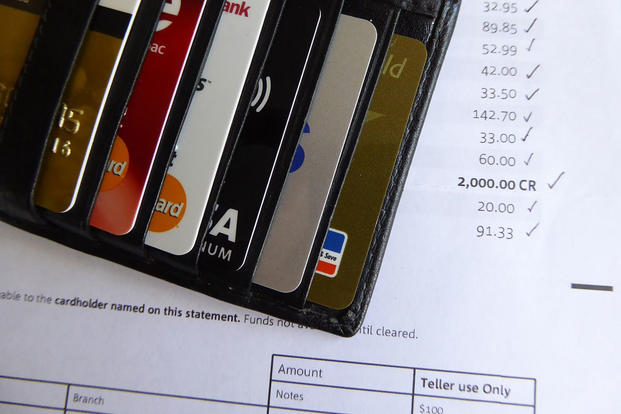Introducing Military.com's new Transition app. Our new app gives you a personalized transition plan, tells you what to expect while transitioning, and even helps you find a job. The app is customizable for all Active Duty, National Guard, Reservists, and spouses. Download it today from Google Play or iTunes.
Among the most popular courses offered by the Family Centers, local community organizations, banks, credit unions, are financial planning seminars. The content of these courses varies from place to place, but you are almost certain to walk away having learned some basic financial planning guidelines.
Here is an eight-step crash course in financial planning. Get a pencil and paper, and pull out your checkbook and recent bank account statements. Find your credit card statements, auto loan payment books or other loan coupons, your federal tax return from last year, and any other relevant documentation.
As you go through the "course," use conservative figures and time frames when planning for periods of unemployment. A healthy dose of pessimism is useful here. Should things ultimately turn out much better than you had planned, you will be pleasantly surprised.
Once you understand your budget clearly, you can then concentrate on getting it under control. This will help to make your transition less stressful.
Step 1. List Your Income
Make a list of all the sources of income you expect to have during your transition from full-time active duty back to ready reserve status, and when you expect to receive the income (weekly, monthly, quarterly, etc.). Include your pay, if any, as well as any unused vacation, severance pay, and unemployment compensation. Also list any interest income (interest from a bank savings account, for example), spouse's income, alimony or child support, and other income you expect to receive on a regular basis.
Next, compute all of the sources on a monthly basis: If the income is weekly, multiply it by four. If it is quarterly, divide it by three.
Note: Be conservative. Estimate the lowest amount you expect to receive from each source of income.
Step 2. List Your Expenses
On a separate list, write down all of your expenses: mortgage; rent; taxes; utilities; food; clothing; insurance (life, health, automobile, homeowners or renters, etc.); car or motorcycle expenses (payments, insurance, registration, gas, maintenance, and repairs); credit card bills; other loans; magazine subscriptions; cable TV; club dues; gifts; job-hunting costs (stationery, printing, dry cleaning, etc.); entertainment and hobby expenses; children's spending money; alimony or child support payments; groceries; personal items; and all other expenses. When listing expenses, take time to think of everything - all the way down to medicines and toothpaste.
Next, list the expense for each item and an average monthly cost. When figuring your average, keep in mind that this is your transition budget. Assume that you will be temporarily unemployed OR your income was reduced after you left full-time active duty. If the cost is not "fixed" (such as rent or mortgage payments that cannot be avoided), plan on the smallest realistic amount you can get by on.
Step 3. Prioritize Your Expenses
After listing all of your expenses, rate them as high, medium, or low priority. High-priority items are things you and your family cannot do without: food, shelter, clothing. Medium-priority items are important to you, but you can exist without them. Low-priority items should be weeded out of the budget process.
Example: Rent or mortgage is an "H"(high priority), while piano lessons for your 10-year-old daughter may be an "M" (medium priority), and cable TV fits into the "L" (low-priority) range.
Step 4. Assign Budget Responsibilities
If you are married, determine who is going to be in charge of staying within the budget for each item on the expense list.
Example: You may take responsibility for the rent and clothing, while your spouse may be responsible for the food budget and music lessons.
Step 5. Establish a Monthly Budget
Subtract your total monthly expenses from your monthly income. If you have more income than expenses, put the extra money in a savings account for emergencies.
If your monthly expenses are more than your income, look over the low- and medium-priority items. Work to reduce some and eliminate others.
Step 6. Identify Additional Sources of Income
If, after all possible cuts have been made, expenses are still greater than income, consider ways to bring in additional money. If your spouse does not currently work, he or she may need to begin working at least part time.
Step 7. Seek Help
Even after you have cut your expenses to the bone and uncovered additional income possibilities, you may still be unable to make ends meet. This is sometimes due to outstanding loan amounts and heavy credit payments. As a final measure, talk to the free Consumer Credit Counseling Service in your area to find ways to work with your creditors to delay payments, reduce interest rates on credit cards or extend the time for loan repayments. This will assure your creditors that you do intend to pay them off over time, and it will help prevent you from going into bankruptcy.
Step 8. Obtain an Up-to-Date Credit Report
It is important to have an up-to-date credit report on you and your spouse. You should obtain one at least six months before your release from active duty. However, if that is not possible, obtain one as within the first 30 days of your return home from deployment.
Get the Latest Financial Tips
Whether you're trying to balance your budget, build up your credit, select a good life insurance program or are gearing up for a home purchase, Military.com has you covered. Sign up for a free membership and get the latest military benefit updates and tips delivered straight to your inbox.











